Day 1 of a long weekend of tours today. After dramatic thunderstorms overnight, it was a bit damp underfoot first thing, but it soon brightened up and we only encoutered one very light (and not forecast!) shower in the afternoon.
The aim for the morning was to explore the farmland inland from the coast and, in particular, to look for raptors. We set off and meandered our way along the country lanes. A Red Kite appeared in the sky beside the road, so we stopped to watch it as it circled overhead. Red Kites were not reintroduced locally but have spread very successfully across the country and are now breeding here. Always a delight to see.
 Red Kite – circled over our heads this morning
Red Kite – circled over our heads this morning
We drove on a little further and stopped to explore. As soon as we got out of the car, a Yellow Wagtail flew over calling. This species has almost disappeared as a breeding bird in Norfolk but a few pairs still cling on in farmland. It is always a nice surprise to encounter one.
We walked up along farm track with tall hedges either side. We could hear Yellowhammers singing and we flushed a couple of birds from the bushes as we walked. A pair of Linnets flew up from the edge of the field. A Whitethroat appeared briefly on top of the hedge singing. In the densest part of the bushes we could hear the delicate piping of a pair of Bullfinches. Generally rather secretive at this time of year, they flew ahead of us as we walked before eventually doubling back overhead and behind us. When the path opened out a little, a pair of Grey Partridge burst out of the tall vegetation along the verge and disappeared across the field, calling.
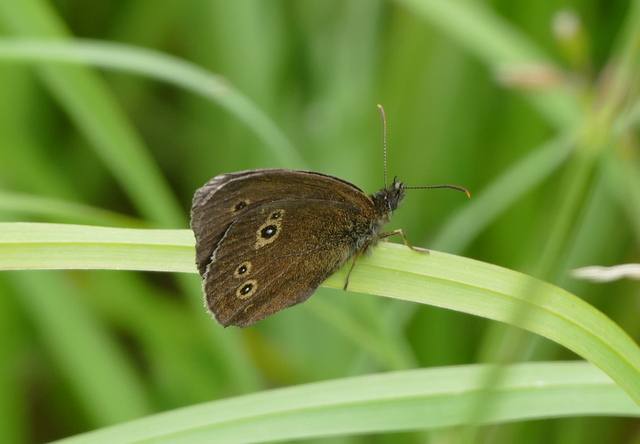 Ringlet – a common hedgerow butterfly at this time of year
Ringlet – a common hedgerow butterfly at this time of year
There were lots of butterflies in the hedgerows as well. Ringlets are much in evidence at this time of year, although some of them are now rather worn and bleached browner rather than the blackish appearance when they are fresh. There were also plenty of Meadow Browns. We saw a number of the smaller Skippers, but we only stopped to look closely at a couple of them, which turned out to be Essex Skippers.
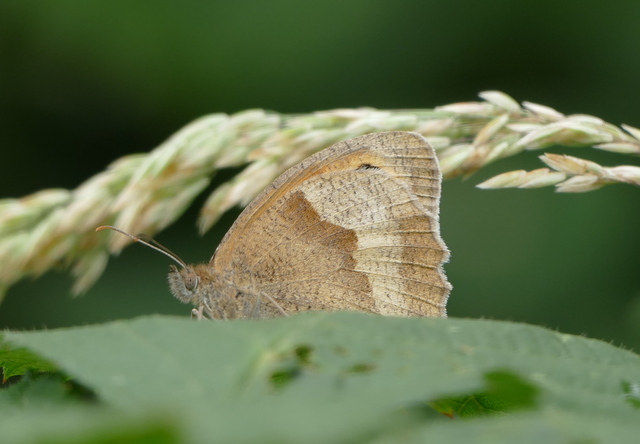 Meadow Brown – also out in profusion at the moment
Meadow Brown – also out in profusion at the moment
We stopped on some high ground from where we could get a good view over the surrounding countryside. Here we stood for a while scanning for raptors. The weather started to brighten up a little while we were there, and we could feel a bit more warmth as it did so. Much better conditions for raptors and a good selection duly appeared, just as we had hoped. That was the cue for the Common Buzzards to start to circle up over the trees. A Kestrel hovered over the hedgerow behind us.
We walked back to the car and drove over towards Titchwell, stopping to explore the area around Choseley on the way there. A Green Woodpecker flew up from the verge beside the road and made a beeline for a telegraph post. It seemed about to land when it realised it was not a tree and veered off across the field. We flushed three or four Kestrels from the hedges either side along a short stretch – presumably a recently fledged family group.
There were several Yellowhammers along the wires and hedges as we drove – this is always a good area for this species. Then two larger birds flew out from the hedge, across the road in front of us and over the edge of the field the other side. Larger, bulkier than the Yellowhammers and a plainer sandier brown, these were Corn Buntings. They flew round and dropped back into the hedge in front of us. Unfortunately, despite pulling forward slowly, we couldn’t see them perched in all the green fresh growth of the hawthorns and eventually they flew again and disappeared across the field.
Around at the drying barns, there was a lot of disturbance today, with vehicles and farm workers busy in the buildings. A Stock Dove perched on the wires was eyeing the small pile of spilled grain. Several Chaffinches and Yellowhammers appeared further along the road. Another Yellow Wagtail flew over calling – it was obviously our lucky day for them today.
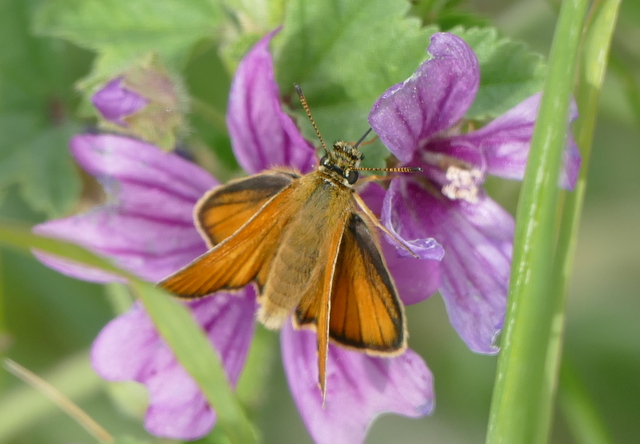 Essex Skipper – we saw several of these today
Essex Skipper – we saw several of these today
From there, we headed down to Titchwell for lunch. While we were eating, we watched a young Robin trying to sneak up on Speckled Wood which was basking in the sunshine on a bench. It snapped at it and caught onto it, but the Speckled Wood flapped vigorously and escaped. It landed nearby and we could see that its wings were already very tatty. Then it flew back to the bench again – perhaps this was a recurring incident?!
After lunch, we walked out onto the reserve. We stopped to scan the reedbed pool. A pair of Great Crested Grebes had a well grown stripy-headed chick with them, and a lone Little Grebe was diving at the back. As well as a little selection if dabbling ducks – Teal, Shoveler, Mallard, Gadwall – a pair of Common Pochard was diving near the reeds. Out in the reedbed, there were still a couple of Reed Warblers singing loudly. A Sedge Warbler flushed in front of us and flew along beside path, landing in the bulrushes briefly before dropping down into the vegetation on the bank.
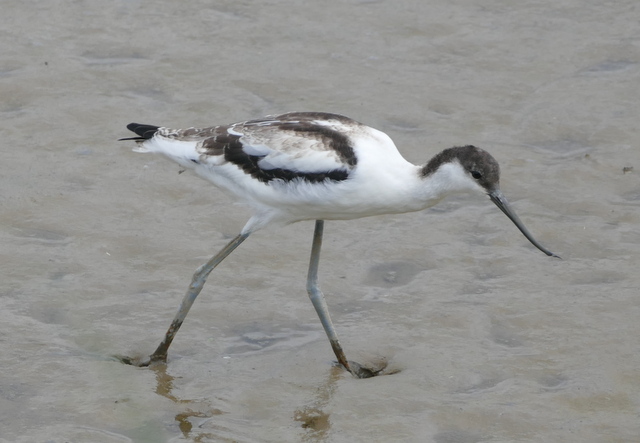 Avocet – over 600 at Titchwell at the moment, this one a juvenile
Avocet – over 600 at Titchwell at the moment, this one a juvenile
As soon as we walked into Island Hide we could see that people were watching the reed edge intently. Sure enough, we also immediately got onto a little group Bearded Tits feeding one the edge of the mud. They were three orangey-coloured juveniles – we got great views of them in the scopes, chasing round at the base of the reeds and hoping out on the mud. With lots of fledged juveniles about, now is a great time to see this often rather secretive species.
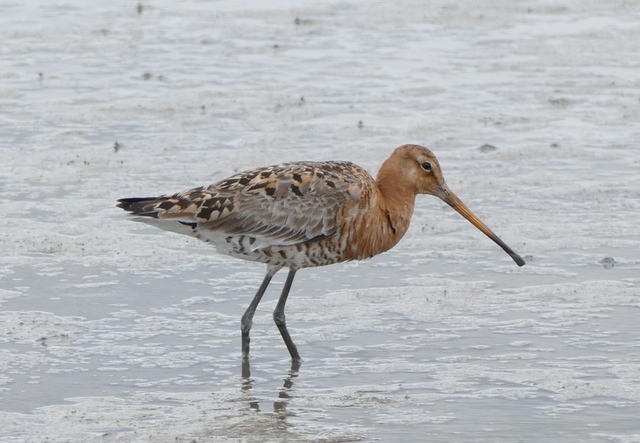 Black-tailed Godwit – there were several hundred of these out on the mud too
Black-tailed Godwit – there were several hundred of these out on the mud too
However, the waders were the real highlight today. The whole of the freshmarsh was thronging with them. The biggest number were Avocets and Black-tailed Godwits. We could see 200+ of both, but particularly the Avocets were lurking amongst the vegetation, so there were probably many more. Interestingly, the Titchwell warden and staff did a full wader count the following day and counted 624, a reserve record! There are a lot more bright rusty-orange birds amongst the Black-tailed Godwits now, as returning adults add to the greyer 1st summer birds that were here first.
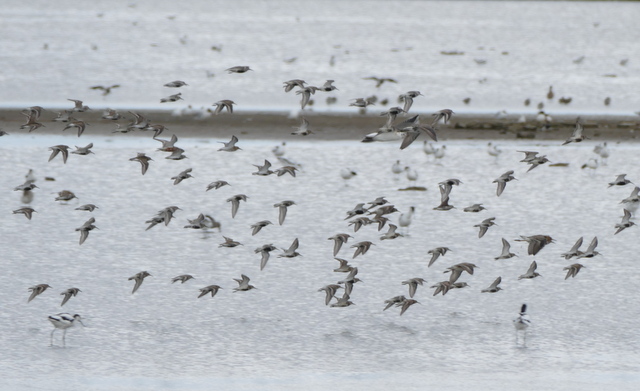 Flock of Dunlin – spot the Curlew Sandpiper amongst them
Flock of Dunlin – spot the Curlew Sandpiper amongst them
There were lots of Dunlin too, well over 100, mostly adults still sporting the smart black belly patches of summer plumage. Lurking amongst them was a single Curlew Sandpiper. Slightly larger, with a slightly longer and more downcurved bill, it too was still mostly in summer plumage. Looking closely through the mass of small waders it was not so hard to pick out, with bright chestnut orange underparts, speckled with white now as it starts to moult.
 Curlew Sandpiper – a moulting adult, still with mostly chestnut underparts
Curlew Sandpiper – a moulting adult, still with mostly chestnut underparts
There were plenty of other waders there as well. A Green Sandpiper and a Common Sandpiper were feeding together on the mud at the edge of the reeds giving a great opportunity to compare these two rather similar species side by side. Towards the back, in the deeper water, at least 6 Spotted Redshanks were in amongst the Black-tailed Godwits. All moulting adults, the Spotted Redshanks ranged from still mostly black summer-plumaged birds, though well-speckled with whiter winter plumage feathers now, to one in particular already much greyer individual.
There are also a lot of Ruff around on the coast at the moment, at least 20 at Titchwell today, and in a confusing mix of colours. The male Ruffs are always amazingly variable, with different combinations of white, black, brown and rusty feathering in breeding plumage. Add in the effects of moult as well, and no two birds look alike!
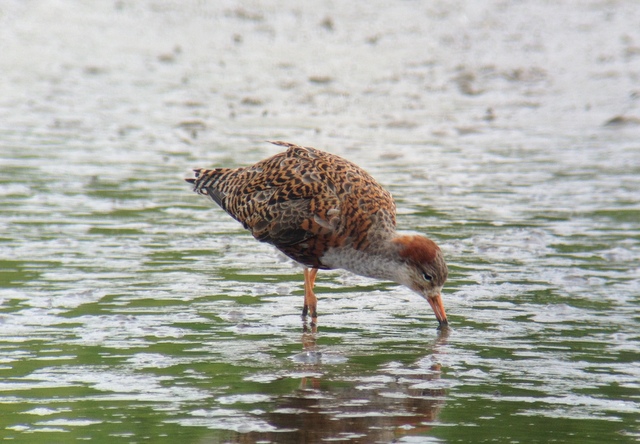 Ruff – a moulting male in a typical mix of colours
Ruff – a moulting male in a typical mix of colours
The Spoonbills were hiding at the back of the freshmarsh, mostly hidden behind the vegetation of the island. They were undoubtedly enjoying their usual favourite occupation and sleeping! One did fly up and disappear over the bank at the back, presumably to feed over towards Brancaster. Another Spoonbill just edged out and stood for a while preening so that we could get a proper look at it in the scope.
Amongst all the seething mass of waders, it was hard to see anything else. Lurking amongst them were still one or two Little Gulls. There have been several 1st summers lingering along the coast for some time, although they are now moulting to 2nd winter plumage with plainer grey upperwings.
 Little Gull – still 1 or 2 on the freshmarsh today
Little Gull – still 1 or 2 on the freshmarsh today
The Volunteer Marsh and tidal pools were quiet again, as they have been in recent weeks. As we walked further along the path, we could hear a Whimbrel calling and we picked it up distantly flying west. Out on the beach, the tide was out and the rocks exposed. A scan through the scope revealed several Bar-tailed Godwits feeding amongst them, including a rather bright orange bird still mostly in summer plumage.There were also several Curlews picking about the rocks and on closer inspection a single Whimbrel was in amongst them. We could see its smaller size, slimmer build and when it turned towards us its rather contrasting dark crown with pale central stripe.
Out on the sea, just beyond the rocks, a single black drake Common Scoter was diving. We could just make out the bright yellow stripe on the front of its bill. A little further east, we picked up four Eider close inshore as well. They drifted past us and we could see they included three 1st summer drakes and a single female.
There were some dark clouds gathering from behind us as we stood on the beach, but the forecast has said there was less than a 5% chance of rain in the afternoon. Needless to say, it did start to rain anyway! Thankfully it didn’t rain very hard and passed over very quickly with the brisk wind, just a very quick shower, so we barely got damp and were quickly dry again. As the cloud passed over, there were lots of Sandwich Terns feeding offshore. A last scan revealed two smart summer plumage Turnstones on the beach. Then it was time to head back.
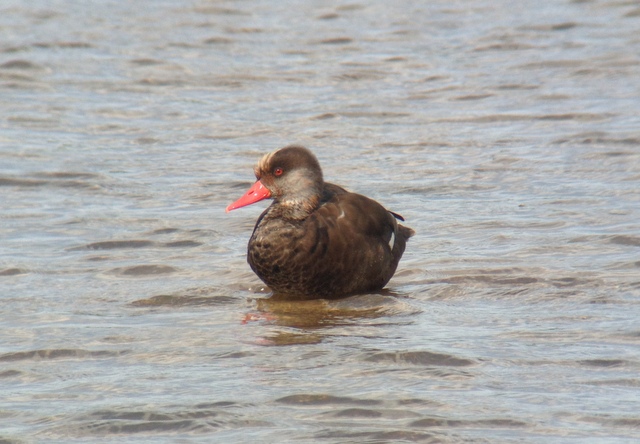 Red-crested Pochard – a red-billed drake moulting into eclipse plumage
Red-crested Pochard – a red-billed drake moulting into eclipse plumage
The pool at Patsy’s Reedbed was mostly quiet apart from six Red-crested Pochards. It was easy to pick out the drakes by their bright, coral red bills but they are already advanced in the moult to drab eclipse plumage. They still retained remnants of summer plumage, with a variable tuft of golden yellow on the front of the crown the only remaining trace of their previously rather smart punk haircuts.
 Marsh Harrier – flew inland to hunt, over Patsy’s Reedbed
Marsh Harrier – flew inland to hunt, over Patsy’s Reedbed
While we were there, a Marsh Harrier flew over past us and headed off inland, presumably to hunt. Something, possibly another harrier, flushed a huge flock of waders off the marshes towards Brancaster. In particular, we could see that there were lots of Curlew out there. From the resulting melee, several Spoonbills flew over – the first one carried straight over the freshmarsh and off towards the saltmarsh at Thornham, and then another two, an adult and a juvenile flew west over the Parrinder Hide. Unfortunately it was then time to head back to give everyone a chance to get something to eat and prepare for the evening’s activity.
Nightjar Evening
We met again later on and headed down towards the coast first. Almost immediately, we found our first Barn Owl out hunting. It quartered over the same field repeatedly, working its way round and round methodically, hovering, occasionally dropping down but repeatedly coming up empty-talonned. We watched it doing this for several minutes, before it then moved off to hunt elsewhere.
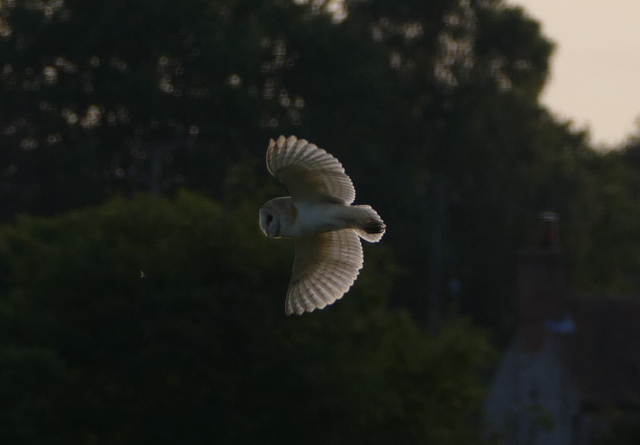 Barn Owl – the first of several this evening
Barn Owl – the first of several this evening
We drove on and parked and then walked out across the marshes. Another Barn Owl was up almost immediately, but disappeared away from us behind some trees. Then a second appeared, again rather distant, and flew out along bank further ahead of us, hunting.
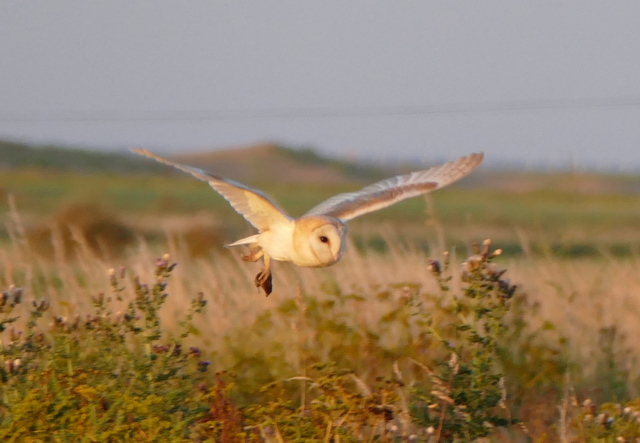 Barn Owl – fantastic views of hunting birds this evening
Barn Owl – fantastic views of hunting birds this evening
Suddenly we could hear all the House Martins alarm calling and we turned round to see a Sparrowhawk flying over. A Marsh Harrier appeared as well and flew away inland pursued by a noisy Oystercatcher. We could hear Bearded Tits calling from the reeds , so we climbed up onto bank from where we could get a good look over them. We could still hear pinging on and off, and after a short while we picked up first one juvenile, then a second, then a third climbing up the reed stems. They perched up for a while in the lovely evening sunlight and we watched them on and off for several minutes, climbing up and dropping back into cover. Then a male Bearded Tit appeared. It too climbed up to the top of reeds, but unfortunately rather than perching out it flew quickly, followed close behind by first a female and then a single juvenile, away over the bank.
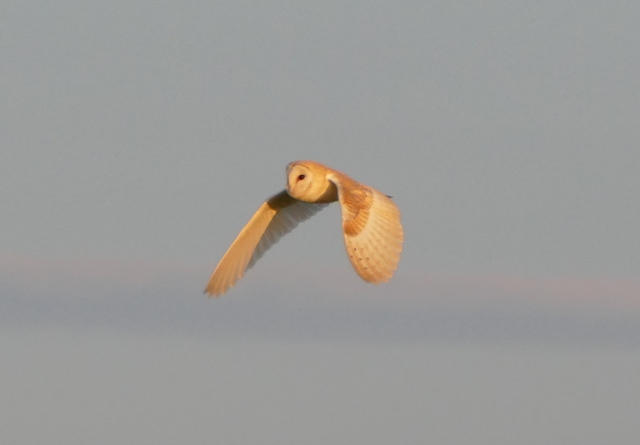 Barn Owl – one bird in particular kept flying back past us with prey
Barn Owl – one bird in particular kept flying back past us with prey
We walked out a little further, and suddenly we picked up the Barn Owl we had seen distantly along the bank earlier coming back towards us carrying prey. It flew straight past us, oblivious to our presence giving us cracking close views. It was obviously taking food back for its young. A short while later, the same Barn Owl came past us again, this time heading back out to what was clearly its favoured hunting ground. We stood and watched it do this three times, flying past us with prey and then back out to resume hunting again shortly after. The evening light was stunning and it was awesome to watch.
 Barn Owl – heading back to the nest with a vole this time
Barn Owl – heading back to the nest with a vole this time
Eventually we had to tear ourselves away and head off inland for the evening’s main billing. It was a nice bright evening, but perhaps a bit cool. The heath was a little quiet at first. Then, bang on cue, a Nightjar began calling. All we had was calling at first, and it was rather slow to start churring this evening. It called several times, paused, and called several times more.
Then suddenly the Nightjar flew out and landed on a tree stump in front of us. It sat there in full view for about ten minutes, looking around, stretching. We got great scope views of it. Even better, while it was sitting there, a female Nightjar flew out and fluttered round him. When she appeared, he spread his wings and tail, flashing his bright white wing and tail patches. We could see her much plainer wings and tail in contrast. Stunning stuff.
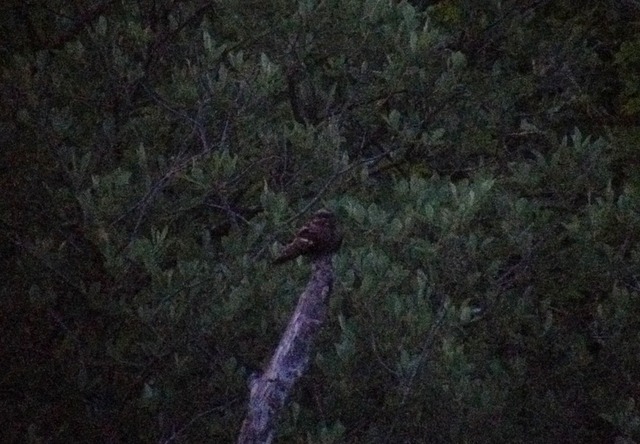 Nightjar – perched up on a stump for about 10 minutes this evening
Nightjar – perched up on a stump for about 10 minutes this evening
He only churred briefly from this post, but eventually dropped down into the gorse and started churring more consistently. We could hear another male Nightjar churring in the distance and somehow the first managed to get round behind us and started churring on that side of his territory in response. A Woodcock flew right overhead, roding – its squeaky call alerted us to its incipient arrival. We could also hear a Tawny Owl calling from the trees away in the distance.
Then another Nightjar flashed past us in the gathering gloom, only about ten feet away. We turned to follow it, and it flew low overhead hunting, jinking from side to side after flying insects. With the light fading, and after such great views, we decided to call it a night.
















